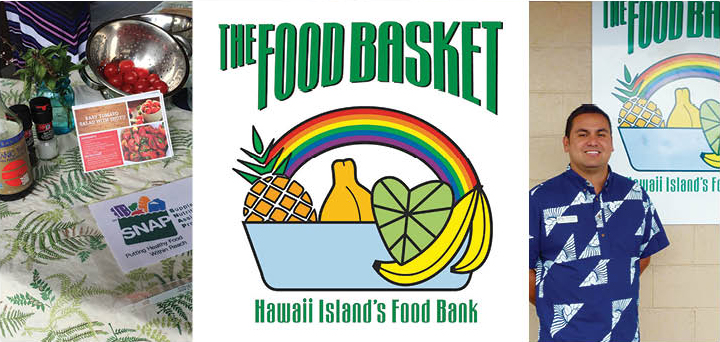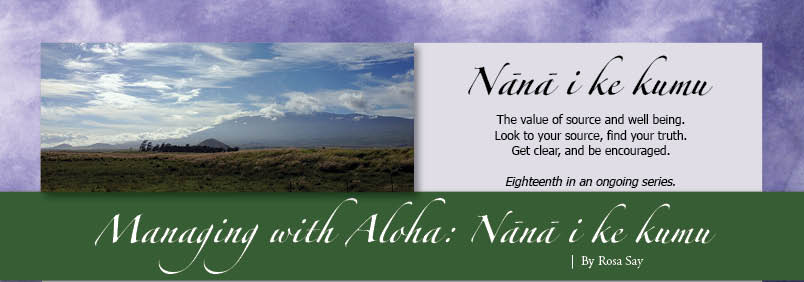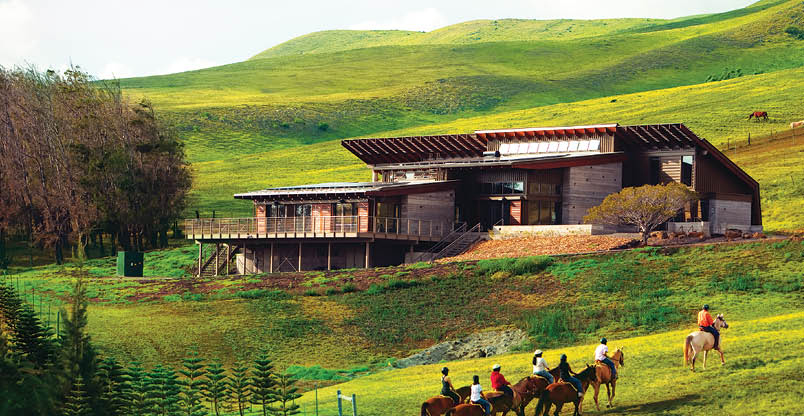
The Food Basket—Hawai‘i Island’s Food Bank, Working to get Food Where It’s Most Needed

By Paula Thomas
On Tuesday mornings, The Food Basket Hilo headquarters is abuzz with traffic: cars, trucks and vans pulling in to deliver fresh produce and canned goods, and people and agencies arriving to purchase. As Kristin Frost Albrecht, Director of Public Relations and Events, puts it: “Tuesdays are really what The Food Basket is all about, a direct connection between farm fresh food (and canned goods) and islanders who are impoverished; and the farm-to-table access for people who want more fresh fruits and vegetables.”
Executive Director En Young seems a beautiful fit as The Food Basket’s leader with his quiet intelligence, a deep caring for the communities he serves, a grounding in the island’s social, cultural and economic history, and a managerial style that keeps staff together as family. He works tirelessly.
Organizations like The Food Basket cannot come close to meeting their mandate without community support in the form of grants, donations, volunteers, and partnerships with other nonprofits, community groups, churches, and the local/federal government. All these interfaces are in place and yet, as one might expect, there is much room for growth and development.
The mission is pretty straightforward: to feed the hungry in Hawai‘i County while attending to the root causes of this critical social problem. To deliver on this means addressing a complex array of issues, transportation being a big one, that go to the very roots of poverty. At the end of the day, says En, “The success story is really how the community can feed itself.”
In The Food Basket’s favor is the fact that Hawai‘i has a long history of food sharing. “What we are doing at The Food Basket is not new in terms of food sharing,” En explains. “The Food Basket acts as a conduit for people who have, to share with those who do not.”
The primary focus is on moving food out to the people who need it. This distributive mission is reflected in many of the programs, including both the new CSA “da Box” program that has a SNAP/EBT (food stamps) incentive price in addition to a retail price, and the USDA Program for seniors. All in all, some 12,000 people per month benefit from The Food Basket’s outreach.
“So what we are doing at The Food Basket is not
new in terms of food sharing,” En explains.
“The Food Basket acts as a conduit for people who
have to share, with those who do not.”
Tuesday is a big day because it is distribution day for the Senior Farmers’ Market Nutrition Program (SFMNP/Senior Produce). The Hilo Civic Center is one of several venues for this. Sometimes it’s the Hilo Tennis Stadium. There, pre-packaged, fresh-from-the-farm produce is lined up: Bags of tomatoes and onions, boxes of mushrooms, cucumbers and papaya by the piece, and bunches of bananas. Whatever is ready for harvest from specific farms in any given week gets plucked, packaged, and placed into the canvas bags of the beneficiaries; in fact, some 1500 senior citizens benefit from the grant that makes this program possible. To boot, volunteers from the Retired Senior Volunteer Program (RSVP) do the actual doling out of the fresh produce. The person-power required to move all this food and distribute it is a lot to orchestrate, and the efficiency of the operation is impressive.
One grantee volunteered that her sister doesn’t usually buy fresh produce at the market, so when this produce comes into the house, she’ll taste things she’s never tried before. For most others, the Tuesday events are a chance to socialize with friends, sample food made using the local ingredients, share recipes, and secure a nutritious bundle for the rest of the week. It’s a true godsend.
“da Box”, or “Ho‘olaha Ka Hua”, is an island-wide Community Supported Agriculture (CSA) program that can benefit all participants. Within the CSA, more than 45 farmers provide fresh produce. Boxes of 5–9 different types of in-season fruits and vegetables are delivered to local sites all over the island once a week for a ten-week period. The boxes are sold at a competitive price that is tiered for income level. The farmers get paid in advance, so the money collected at distribution goes toward the next purchases from the farmers.
While very successful, the “da Box” program would have more impact if there were at least 1,000 people being served instead of the current 300. The economies of scale would bring the cost of “da Box” down for everyone and supply more households. Getting more people to participate is a high priority.
Perhaps the biggest challenge facing The Food Basket relates to transportation. The strategy to get food out to the community means having working vans and trucks, and enough of them. The costs associated with replacing vans or expanding the fleet are not provided for in the annual operating budget.
Partnerships are therefore critical, as are government sources of support. “However,” notes En, “the [federal] government funding we receive is only 15% of our overall budget, although most people think the percentage is much higher. We get support from the County, too, but most of our funding comes from grants and private donations. We leverage our programs through our partnerships with organizations like the Kohala Center, the Agricultural Extension Service, the Weinberg Friends Program, and community service groups like Rotary and Lions.
The Food Basket’s website provides a wealth of information about its programs and how to participate in them. It also illuminates some of the island’s poverty issues. It reports, for example, that two out of three children in Hawai‘i Island schools are on free or reduced lunch. To address this, the “We Got Your Back” program issues supplemental nutrition bags to eligible school children for long weekends and holidays.
At The Food Basket there is no lack of effort or creativity when it comes to moving food out to those in need. En and his staff continue to look at existing systems they can tap into to expand their reach. In addition to the food pantries, soup kitchens, the DOE, and community centers, staff are looking at the structures used, for example, by Civil Defense to see how food distribution channels can be extended even further into the community.
There is also no lack of creativity on the part of community groups when it comes to supporting The Food Basket with donations. This, in fact, can even be problematic. Scores of unsolicited drives for The Food Basket take place throughout the year, with the best of intentions.
However, “The community needs to coordinate needs and resources,” says En. When there is no coordination, The Food Basket gets items that don’t fill gaps in inventory, or may not be in line with what is needed at the time. “It would be so much more beneficial for everyone,” says En, “if people would contact us first, before they do a drive, and ask us what needs we see.”
Working together in a strategic way, by sharing information and collaborating on many levels, we can all support the mission to put Hawai‘i Island where it belongs, at the forefront of our state’s agricultural sector and the model for sustainable living. ❖
Contact The Food Basket: 808.933.6030
Contact the writer


